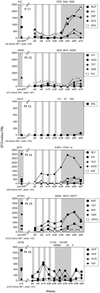Stimulation of HIV-specific cellular immunity by structured treatment interruption fails to enhance viral control in chronic HIV infection
- PMID: 12370434
- PMCID: PMC129766
- DOI: 10.1073/pnas.202372199
Stimulation of HIV-specific cellular immunity by structured treatment interruption fails to enhance viral control in chronic HIV infection
Abstract
Potent antiretroviral therapy (ART) suppresses HIV-1 viral replication and results in decreased morbidity and mortality. However, prolonged treatment is associated with drug-induced toxicity, emergence of drug-resistant viral strains, and financial constraints. Structured therapeutic interruptions (STIs) have been proposed as a strategy that could boost HIV-specific immunity, through controlled exposure to autologous virus over limited time periods, and subsequently control viral replication in the absence of ART. Here, we analyzed the impact of repeated STIs on virological and immunological parameters in a large prospective STI study. We show that: (i) the plateau virus load (VL) reached after STIs correlated with pretreatment VL, the amount of viral recrudescence during the treatment interruptions, and the off-treatment viral rebound rate; (ii) the magnitude and the breadth of the HIV-specific CD8(+) T lymphocyte response, despite marked interpatient variability, increased overall with STI. However, the quantity and quality of the post-STI response was comparable to the response observed before any therapy; (iii) individuals with strong and broad HIV-specific CD8(+) T lymphocyte responses at baseline retained these characteristics during and after STI; (iv) the increase in HIV-specific CD8(+) T lymphocyte frequencies induced by STI was not correlated with decreased viral set point after STI; and (v) HIV-specific CD4(+) T lymphocyte responses increased with STI, but were subsequently maintained only in patients with low pretreatment and plateau VLs. Overall, these data indicate that STI-induced quantitative boosting of HIV-specific cellular immunity was not associated with substantial change in viral replication and that STI was largely restoring pretherapy CD8(+) T cell responses in patients with established infection.
Figures




Comment in
-
Interruption of antiretroviral therapy to augment immune control of chronic HIV-1 infection: risk without reward.Proc Natl Acad Sci U S A. 2002 Oct 15;99(21):13377-8. doi: 10.1073/pnas.212518999. Epub 2002 Oct 7. Proc Natl Acad Sci U S A. 2002. PMID: 12370421 Free PMC article. Review. No abstract available.
References
-
- Mellors J W, Rinaldo C R, Jr, Gupta P, White R M, Todd J A, Kingsley L A. Science. 1996;272:1167–1170. - PubMed
-
- Hogan C M, Hammer S M. Ann Intern Med. 2001;134:978–996. - PubMed
-
- Hogan C M, Hammer S M. Ann Intern Med. 2001;134:761–776. - PubMed
-
- Sewell A K, Price D A, Oxenius A, Kelleher A D, Phillips R E. Stem Cells (Dayton) 2000;18:230–244. - PubMed
-
- Picker L J, Maino V C. Curr Opin Immunol. 2000;12:381–386. - PubMed
Publication types
MeSH terms
Substances
LinkOut - more resources
Full Text Sources
Other Literature Sources
Medical
Research Materials

